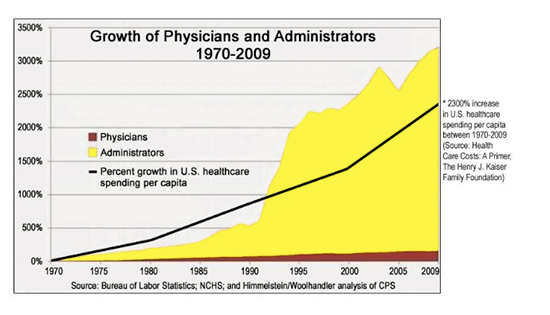This week, my friend and colleague, Alex Berezow, wrote a piece, Is the US doctor shortage intentional? The writers at ACSH share their work before publication to get feedback and in the case of Alex’s latest, we disagreed. While much of what he wrote is factual, without the nuance of the setting, it fails to tell the entire story. So here is not so much my rebuttal but the rest of the story.
“Don’t tax you, Don’t tax me, Tax that fellow behind the tree.”
Alex is correct that healthcare costs are high, whether you peg them against income, GDP, or outcome. He is also correct in saying that there is a blame game where each actor in the healthcare play blames someone else. His argument is essentially one of supply and demand. He begins with the high salaries paid to physicians. He ultimately ties it to the continued reports of physician shortages, which he feels may, in the guild-like ways of physicians, be somewhat intentional.
Let's begin with salaries. I will not apologize or defend my earnings as a physician; my free-market self says I was paid what the market was willing to pay. But, for the most part, physician payments have generally declined over the last 30 years or have not kept up with inflation. As a vascular surgeon, my practice was primarily for Medicare beneficiaries, so I am particularly sensitive to Medicare fee changes. While commercial insurance pays better, it is often just a percentage of Medicare’s payments, roughly 120%. In effect, Medicare sets and caps the fee-for-service charges for most physicians and advanced practitioners. [1]
For most physicians, especially now in a budget-neutral environment, fees have declined. For example, a carotid endarterectomy, removing atherosclerotic buildup in the artery supplying your brain that may potentially or actually have caused a stroke, was paid by Medicare $1200 - we can tussle over whether that amount is excessive another time - today, the same procedure, with the increased overhead of insurance, staff, and billing [2] pays $900.
Economically, physicians have few options. Most have left private practice and are now employees of large health systems. Their salaries are derived not simply from the revenue they generate but from the downstream services and payments accruing to the health systems they share. For those remaining in smaller group practices, an increased workload is the only means to drive revenue. Advanced care practitioners, nurse practitioners (NPs), and physician assistants multiply physician services. The economic arbitrage is either I pay them a set percentage of what revenue they bring in, increasing my income by the difference, or they keep what they earn, and I gain access to patients needing more procedural care without the cost of identifying them.
Shortages or Inequitable Distribution?
Let's imagine an endless stream of medical students. They will select specialties based on where they choose to live, what interests them in medicine, and what type of lifestyle they desire. The selection process for medical school is designed to identify high-interest, high-performing individuals. Roughly 40% are accepted, but this belies that the group being considered is already elite. Anyone with a passing knowledge of freshman chemistry and physics knows that only about 17% of declared “pre-meds” apply. Leaving aside the recent concerns about equity in admission and the use or misuse of “DEI,” few physicians completing their residency training choose rural areas; they went to college and medical school in more urban centers and presumably have been influenced as to life's joys and rewards. While some believe a life-work balance is to be found in hunting and fishing and living in a rural area, that is not frequently the case. Moreover, and I say this with experience, working in a rural setting can be professionally lonely – where do you turn when you want to discuss a case or share a good or bad outcome?
Given the mindset of a young professional to support their family in the manner they desire, fewer choose low-paying specialties - we have fewer pediatricians and primary care physicians. Raising their pay would be a solution, but so would moving NPs into those slots. Of course, after a while, the NPs will want pay parity with the docs; they already insist upon that in terms of licensure and titles.
Another salient reason why unlimited medical school admissions would be problematic is experience. The literature suggests that with more experience comes a better skill set and patient outcomes. The rate-limiting factor is how many patients a resident cares for during training. Two residents cannot “share” one patient; physician training requires a resident to be held responsible for their patients – managing and working within a team comes after you have learned how to manage and work with those assigned to your care.
Declaring a hospital a teaching hospital does not make it so.
The recent increase in medical schools and their associated teaching hospitals is primarily driven by what Alex described as federal financial support for physician training. [3] Patients will not want "students," and teaching medicine and surgery is a different skill set than doing medicine and surgery. Academia still does not reward teaching, and it is improbable that community physicians, now finding themselves in a “teaching hospital,” will be willing to put their patients at risk). As a result, the experience gathered in training is diluted as you add more trainees
Some new medical schools are opening in Montana, etc., where we will, I think, see some improvement. Still, most cases are increasing medical school enrollment to bring in tuition and, more importantly, those federal payments for training. Academic programs opened medical schools in the past, but today, health systems do - are the goals aligned?
We can make a good case for importing medical talent, but this is another form of exploitation. These low- and middle-income countries have the same problems in training MDs, more so in many cases, so a deliberate attempt to recruit them is, to be “woke,” another form of resource theft. I have no problems with the free flow of physicians, but recruitment is, for me, a bridge too far.
Why is healthcare expensive? All that Alex touched upon. Hopefully, what I have just written provides a more nuanced view. If I had to pick out the low-lying fruit, I would point to the cost of medications and administrative expenses. The US accounts for 64% of pharmaceutical revenue, although we use only 26% of the total product. The US is the piggy bank for pharmaceuticals, and our costs are used to shore up the discounts for other countries. When you think about pharmaceutical economies, you have to think globally. Ozempic is $125 in Denmark, down from $188. A comparable dose in the US ranges upwards to $1000. Globally, you can rob Peter to pay Paul.

Administrative costs, as compared to labor costs, have risen dramatically. The Commonwealth Fund reports that Canadian hospital and physician administrative costs were 40% less than in the US. Administrative costs are often hidden but are reflected in increased hospital costs, insurance, and physician costs.
It is true that physicians seek to protect their role and income. Much of the fighting about the scope of care involves turf wars between physicians and advanced care practitioners. However, there are also legitimate concerns about training and judgment. Generally, I do not frequently ascribe intent to human behavior. As I have said, “Only the Shadow knows what lurks in the heart of man.” Alex and I did agree on the value of my new favorite thought, Hanlon's rule.
“Never attribute to ill intent that can be more easily explained by incompetence.”
I would add that we might also need to consider human behavior with a dash of market forces.
[1] There are exceptions. Physicians providing elective care who do not accept any insurance, like plastics, dermatology, and some orthopedics, where there is no limit. Most physicians, now employees of healthcare systems, may receive weekly salaries, but those salaries are based on Medicare’s fee-for-service relative value units, a “measure” of work and payments.
[2] One calculator puts increased costs at approximately 60% from 1988 dollars.
[3] Suffice it to say that the added income associated with resident training may not cover their entire cost. Still, their salaries during training are so low that, combined with the government subsidies, they represent free professional labor to health care systems.




